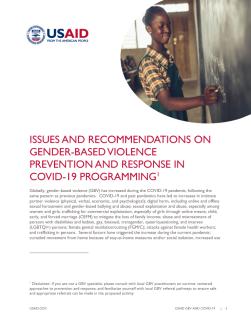Globally, gender-based violence (GBV) has increased during the COVID-19 pandemic, following the same pattern as previous pandemics. COVID-19 and past pandemics have led to increases in intimate partner violence (physical, verbal, economic, and psychological); digital harm, including online and offline sexual harassment and gender-based bullying and abuse; sexual exploitation and abuse, especially among women and girls; trafficking for commercial exploitation, especially of girls through online means; child, early, and forced marriage (CEFM) to mitigate the loss of family income; abuse and mistreatment of persons with disabilities and lesbian, gay, bisexual, transgender, queer/questioning, and intersex (LGBTQI+) persons; female genital mutilation/cutting (FGM/C); attacks against female health workers; and trafficking in persons. Several factors have triggered the increase during the current pandemic: curtailed movement from home because of stay-at-home measures and/or social isolation, increased use of the Internet, reduced access to support networks, and financial stress. Some reported GBV incidence data indicate decreases in GBV, which are likely due to underreporting.
This document is excerpted from USAID’s comprehensive gender and COVID-19 guidance, and presents considerations and recommendations related to gender-based violence (GBV) prevention and response (including sexual exploitation and abuse ([SEA]), that are relevant across sectors. Each sector-level recommendation includes additional tags to cross reference other relevant sectors.

